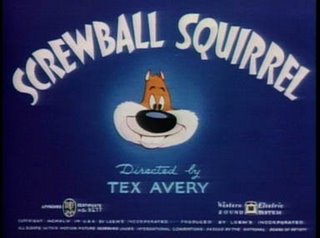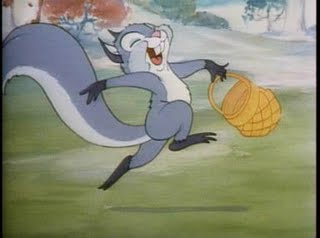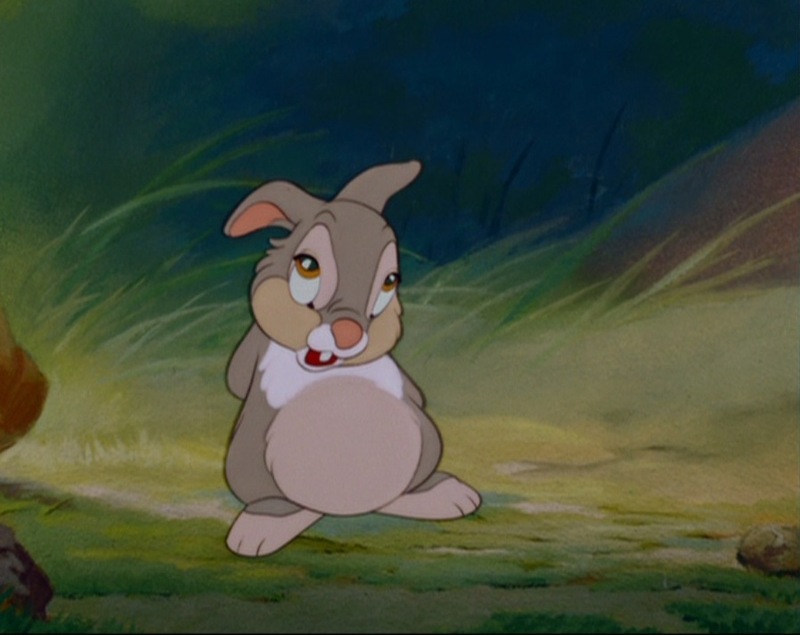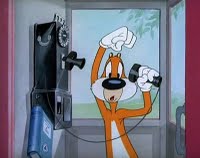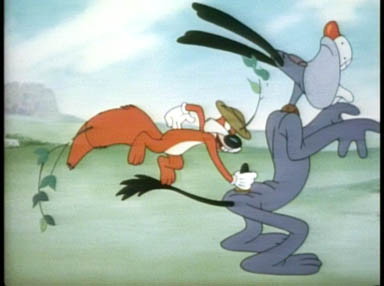The following was written for the May 1976 issue of Monthly Film Bulletin. —J.R.
Screwball Squirrel
U.S.A., 1944
Director: Tex Avery
Cert—U. dist—Ron Harris. p.c—MGM. p—Fred Quimby. story—Heck Allen. col—[originally made in Technicolor]. anim—Preston Blair, Ed Love, Ray Abrams. m—Scott Bradley. 248 ft. 7 min. (16 mm.).
After beating up Sammy Squirrel — an effeminate Disney-like creature who purports to be the hero of the cartoon — Screwy Squirrel enters a phone booth and calls Meathead the dog to get another plot going. After an extended chase, Meathead tries to end the cartoon, but Screwy offers him one more chance to catch him. The results are immediately complicated by the fact that both confess to have been twins all along; a revived Sammy joins the group.
As Joe Adamson had ungrammatically but aptly noted, “Screwy Squirrel is Daffy Duck taken one step further that he absolutely has to.” A thoroughly demented character who lasted through five cartoons in the mid-Forties (Screwball Squirrel, Happy-Go-Nutty, Big Heel-Watha, The Screwy Truant, and Lonesome Lenny), he seems important in Avery’s career not so much for his own intrinsic qualities — monotonously aggressive mania and not much else — as for the wild bouts of anti-illusionist high jinks and comparable assaults on the audience that he provoked in his creators. Screwball Squirrel, the first in the series, establishes its position at the outset by brutally eliminating a cuddly Disney prototype who insists on enumerating his fluffy forest friends in an endless litany — a rude parody of the more homogenized Disney manner which anticipates the delightfully disrespectful opening of Avery’s The Peachy Cobbler six years later. From then on, the adventures are as outrageously illogical and as disruptive of ordinary narrative as possible. In the course of the chase, a fragment of music and a few seconds of physical flight simultaneously become “stuck” — in a maneuver prefiguring the tortured climax of Pere Portabella’s live-action Umbracle (1972) by well over two decades — until Screwy reaches a gramophone in the middle of a meadow, and sets the needle forward; Meathead lifts up a corner of the frame like a page to catch a glimpse of the next gag (Screwy escapes inside a tree trunk, which he subsequently leaves on a streetcar); and it turns out that a long drum-roll accompanying Meathead’s journey down a hill in a rolling barrel is being performed on one side of the screen by the sinister squirrel himself. Suffering somewhat in a black-and-white version (which half-spoils a gag where the two leads become seasick), and with an unfortunate continuity leap near the print under review which adds a confusing hiccough to the driving staccato rhythms—Screwball Squirrel still exhibits a sheer destructive energy that places it among Avery’s most exhilarating and valuable works.
JONATHAN ROSENBAUM
—Monthly Film Bulletin, May 1976, vol. 43, no. 508

